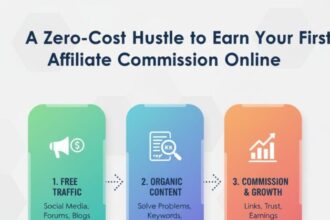My Brain vs. The Algorithm: Why Google Is Ignoring Your Site Titles and Meta Description During Search, and How I Finally Started Winning.
It was late into the night, and the only things awake in my house were me and the low hum of the refrigerator.
My wife had been asleep for hours. But me? I was stuck. Glued to my monitor, caught in that awful, addictive loop of typing something into Google and hitting refresh. Again. And again. Like I was pulling a slot machine lever, praying for a different result.
Every single time, though, it came up lemons. It was pure disappointment.
You see, I had written what I truly thought was the perfect title for a blog post I’d just published. It was clever. It had the keywords. I even thought it was kind of beautiful, in a nerdy, writerly sort of way. I’d also written a meta description so darn persuasive, I figured anyone who read it would have no choice but to click.
I hit the publish button feeling that rush. That little hit of “I’ve done it. I’ve finally figured this thing out.” But Google, in its infinite and completely uncaring wisdom, had other plans.
It didn’t just ignore my work. It felt like it had taken it out back and roughed it up. My clever title was gone, replaced by something so bland it was practically invisible. And my beautiful meta description? Poof. Vanished. Instead, it had just snagged a random, clumsy sentence from the middle of the article. My carefully arranged digital storefront was a mess, with a new sign that basically said, “Store Here. We Have Stuff, I Guess.”
I was genuinely baffled. It felt personal. And right there, in the blue glow of my screen, I knew I had a serious problem. I had absolutely no idea why Google is ignoring my site titles and meta description during search and how to fix it. That night was the start of a deep, deep rabbit hole. A journey that was part frustration, part obsession, and part discovery.
So if you’re up late, staring at your own mangled search result and wondering what cosmic sin you committed, pull up a chair. This is my story.
My First Clumsy Steps Into This.
So where did I start? I Googled it. The irony was not lost on me, believe me.
And what I got back wasn’t an answer. It was a firehose to the face. A tsunami of articles, old forum posts from 2011, and videos of guys talking way too fast in front of whiteboards. The information overload was instant and overwhelming.
And the language they used… my god. It felt like it was designed to make you feel stupid. SERPs, CTR, schema, crawlers, canonicalization. I was drowning in a sea of acronyms. All I wanted was for my title to show up. That’s it. Just the title I wrote.
But slowly, painfully, a picture started to form through the haze. The heart of my issue had a name: Google rewriting titles. And it wasn’t a mistake or a bug. It’s a feature. The Google bots, its little digital spiders, are programmed to do one thing above all else: give the searcher the most relevant result. If your title gets in the way of that, it gets the boot.
That was the first piece of the puzzle that actually clicked into place. It made me realize I’d been looking at the entire problem from the wrong side of the fence.
Playing a Game Without Knowing the Rules
My first attempts to “fix” the problem were just me fumbling in the dark. I’d read one article that said my title was too long, so I’d chop it down. Then I’d see another saying it wasn’t descriptive enough, so I’d tape some words back on.
I was playing a game of whack-a-mole, but I was blindfolded and the moles were invisible.
It was like trying to bake a cake for a judge you’ve never met. You bake this gorgeous chocolate cake—that’s your title. You frost it perfectly—that’s your meta description. But then the judge decides one person at the table might want vanilla instead. So, they scrape your hard work off and replace it with a thin, sad layer of their own. For someone else, they just carve out a jagged piece of the cake with no frosting at all, because they figure that’s all that person really needs.
You made the cake, yeah. But how it’s actually served up is completely out of your hands. It was maddening. My sense of control just vanished, and this low-grade frustration became my new normal.
My Masterpiece: The “Pajama Paradox” Debacle
I remember the exact moment I hit my breaking point. I had written this post about the weirdness of working from home. I spent probably an hour just on the title.
The title was: “The Pajama Paradox: Conquering the Couch and Crushing Your Career From Home.” I loved it. It had my voice. It was fun. It felt… right. A week later, I worked up the courage to search for it. I typed in “challenges working from home.” I scrolled, my stomach in a knot. And then I saw it. My article.
Except the title read: “Tips for Working From Home.” I just stared at the screen. “Tips for Working From Home.” It was so… empty. So corporate. It was the beige cubicle of titles. Google had looked at my little spark of personality and just snuffed it out, replacing it with something from an HR manual.
That was the moment I knew I had to throw out everything I thought I knew. My whole approach was broken. I wasn’t just failing to communicate with Google; we were speaking different languages. And it was pretty clear I was the one who had to learn a new one.
Turns Out, a Lot of What We’re Told Is Just… Wrong
As I dug in deeper, something started to dawn on me. A lot of the so-called “best practices” that get passed around in the blogosphere are either ancient history or were never really true to begin with.
It felt like peeling an onion. Every layer I pulled back revealed another myth I’d been clinging to. And honestly? It made me kind of mad. I thought about all the hours I’d sunk into this, all the creative energy I’d wasted chasing things that didn’t matter.
So let’s bust a few of these myths right now. This is the stuff I wish someone had just told me upfront.
That Whole “Set It and Forget It” Thing? Yeah, That’s a Lie.
For the longest time, I thought of a title and meta description as a one-and-done deal. You write it, plug it into the little boxes in your SEO plugin, and boom, you move on with your life.
Nope. Not even close. The truth is, your title isn’t set in stone. It’s a suggestion. A polite request. You’re raising your hand and saying, “Hey Google, I think this is a pretty good way to introduce my page.” But Google always, always reserves the right to say, “Thanks, but I’ve got a better idea.” And the number one reason it does that? The searcher.
This was a huge mental shift for me. I stopped seeing my title as a fixed label and started seeing it as an opening line. The start of a conversation. And any good conversation changes depending on who you’re talking to. This is where that term user search intent comes in, and trust me, it’s not just a buzzword. It’s everything.
Basically, Google is obsessed with answering the user’s question. Fast. If someone is looking for my “pajama paradox” book idea, my clever title might work perfectly. But if they’re in a panic and just search “how to be productive at home,” let’s be honest, “Tips for Working From Home” is a more direct answer to their prayer. Google isn’t trying to hurt my feelings. It’s trying to be a good waiter for the person who just walked in.
The Trap of the “Perfect Keyword”
This was another pitfall I happily jumped right into. I’d spend hours searching for that one magic keyword phrase. And once I had it, I’d cram it into my title and description like I was trying to stuff a sleeping bag into a tiny sack.
I thought my job was to wave a flag at the Google robot and shout, “HEY! THIS PAGE IS ABOUT THIS EXACT THING!”
But I was talking to a robot that grew up and got smart a long time ago.
Today’s Google gets the idea behind your words. It understands synonyms. It understands context. It knows “how to make good coffee” is the same idea as “best coffee brewing methods.” You don’t need to repeat a phrase five times to get your point across.
In fact, doing that can actually work against you. It looks unnatural. It looks spammy. It looks like you’re trying to cheat. And a title that looks like it’s trying to cheat is the first one to get rewritten. One approach feels like a conversation; the other feels like a sleazy sales pitch.
Thinking Clicks are Just a Score. (They’re the Whole Game).
I’m a little embarrassed to admit this one. I really didn’t think about the click-through rate (CTR) that much. I figured, hey, if I get on the first page, that’s the win. The clicks will just… happen.
But what I finally understood is that the CTR isn’t just the result of a good ranking. It’s also a cause of it.
Think about it like this. Google shows 10 results. If everybody who searches scrolls right past result #2 and clicks on result #3, what does that tell Google? It tells them that #3 is probably the better, more interesting, more helpful answer. So over time, Google’s going to say, “Well, why is #2 even ranked higher?” and it’ll probably swap them.
Your title and meta description are your billboard on the world’s busiest highway. They’re your only chance to make a real person choose you over nine other options. A higher CTR is a massive vote of confidence. A study from Moz, a big name in this world, confirmed this relationship ages ago. So a boring, rewritten title isn’t just an insult to your ego. It’s actively making your billboard less appealing, which can sink your ranking over time. It’s a nasty downward spiral.
The One Simple Idea That Finally Made It All Click
I was at my wit’s end. After weeks of reading, experimenting, and drinking way too much coffee, I was ready to just throw my hands up and write whatever I wanted, and let the chips fall where they may.
And then, the breakthrough came. It wasn’t some complex formula or a secret hack I found on a hidden forum. It was just… a change in how I looked at it. A new metaphor that popped into my head out of sheer exhaustion and blew the whole thing wide open.
Here it is: Your title and meta description are not a resume you’re submitting for a job. They are the sign on the front of your shop.
Just sit with that for a second. This one idea changed everything. It instantly re-framed my role in this whole dance. It took the focus off the big, scary, mysterious algorithm and put it right back where it belonged: on the person I was trying to reach.
I Was Trying to Please the Landlord, Not the Customer
For weeks, I’d been obsessed with pleasing the Google bot. It was my single audience. What does it want? What words does it like? I was acting like a nervous tenant trying to impress the landlord of my building.
But you don’t paint the sign on your shop for the landlord. The landlord just provides the building.
You paint the sign for the people walking down the street. And that sign has only two jobs to do. First, it has to accurately tell people what’s inside. Second, it has to look interesting enough to make them want to turn the knob and walk in. That’s it. It’s that simple. If your sign says “Artisanal Cheese” but you sell car batteries, the sign is a failure. And if you have the best cheese in the city but your sign just says “Shop,” it’s also a failure, because no one has a reason to care.
My “Pajama Paradox” title? It was a sign with a fancy, swirly font. It was cute, but it wasn’t clear. “Tips for Working From Home,” while boring, was a very, very clear sign. It told you exactly what was inside. This also solved my anxiety about meta description length. It’s not about the exact character count; it’s about getting your best pitch on the sign before it gets cut off by the doorframe. My whole content process, which I moaned about in another post about my content planning woes, got so much easier when I started thinking this way.
From Giving Orders to Starting a Conversation
This “shop sign” idea changed my whole posture. I went from trying to give Google an order to trying to start a conversation.
I stopped trying to force Google to use my title. You can’t. Instead, I started trying to help Google by giving it the best possible sign for my shop. A sign that is clear, honest, and speaks to the exact kind of person I want to attract. My job isn’t to outsmart the machine. My job is to make the machine’s job easier.
When I give it a fantastic, human-focused title and description, I’m basically saying, “Hey Google, I put a lot of thought into this. I think this is a really great and honest way to describe my page to a person. Feel free to use it if it helps.”
And the craziest thing happened. The more I did that, the more often Google just… agreed with me. The moment I started writing for the person, the machine finally started to listen.
My Personal Scrappy Guide to Actually Doing This Stuff
So. After all that. What do I actually do now when I’m about to post something? I gotta be clear: this isn’t magic. It’s not a foolproof system. This is just my personal checklist, the stuff I do that seems to work. It’s what helps me sleep at night instead of falling down that 2 AM refresh-hole. This is my cobbled-together method for dealing with the whole why Google is ignoring my site titles and meta description during search and how to fix it nightmare.
1. First Things First: I Play Detective.
Before a single word of a title gets written, I stop. I just think for a minute. “Who is this for? And what are they really feeling when they search for this?” Are they frustrated? Curious? In a hurry? Are they a total beginner who is scared of jargon, or an expert looking for a specific detail? This is all about that user intent stuff. I try to make the promise of my title match the soul of my article. If it’s a guide for newbies, I use words like “Simple,” “First Steps,” or “No-Nonsense Guide.” If it’s a huge list, I put the number right up front. It’s not about tricking an algorithm. It’s about making an honest promise to a person.
2. I Think in “Snippets,” Not in Pieces.
I stopped seeing the title and the meta description as two separate chores. They’re a team. A single unit. They are the snippet. And their job is to work together to tell a tiny, compelling story.
My rules for titles are dead simple now:
(a) Clear is better than clever. My ego fought this for a long time, but it’s true.
(b) Promise the ‘what’ and the ‘why.’ What is this page? And why should you care? “A Simple Guide to Sourdough” (the what) “For Bread That Will Make You Weep” (the why).
(c)The first three words are everything. I put the most important stuff right at the beginning. I assume people are scanning, not reading.
And for the meta description, I write it like a tiny movie trailer:
It’s an invitation. I try to end it with a little nudge. “Here’s how to start,” or “See the simple steps inside.”
It builds on the headline. It gives a little more detail, a little more flavor. It doesn’t just repeat the title.
It has a pulse. “This guide shows you…” feels a thousand times better than “You will be shown in this guide…”
This whole process of crafting compelling snippets takes me maybe ten minutes, but it’s the most important ten minutes I spend.
3. The Meta Description is My Secret Handshake.
I’ve come to see the meta description as my secret weapon. Even Google’s own developer guides admit they rewrite titles all the time. But a great meta description can be a powerful guide. It can whisper in Google’s ear and give it a better idea of what the page is really about, which can lead to a better title even if it’s one Google creates.
My approach now is to just talk to the person. “Tired of confusing sourdough recipes? This guide cuts right through the jargon. We’ll walk you step-by-step from a totally dead starter to a perfect, crusty loaf you can brag about. Seriously. It’s easier than you think.”
It connects with a feeling (tired of confusion), offers a solution (cuts through jargon), and paints a picture of success (a perfect loaf you can brag about). It’s a tiny pitch powered by empathy. The folks at Ahrefs have a solid guide on this that’s worth reading if you want to go deeper.
4. I Listen to the Echo.
This is the one I kicked myself for ignoring for so long. A few weeks after a post goes live, I go into Google Search Console (it’s free, you should use it). The “Performance” report there shows me the exact words people typed into Google to find my articles. It’s like being able to read your customers’ minds. It’s priceless.
If I see a ton of people finding my article by searching “why is my sourdough starter flat and watery,” that’s not just data. That’s a cry for help. It’s a direct message from my audience. And so, I listen. I might go back and tweak my title to mention “flat starter.” Or even better, I’ll write a whole new post just on that. I’m just using their words to write my signs.
5. And I Don’t Forget the Rest of the Family.
Finally, the big lesson. The title and description aren’t out there on their own. They’re part of a family: the on-page SEO elements. Google doesn’t just look at your title tag. It looks at your big H1 headline on the page. It looks at your subheadings. It looks at the words you use. If my title tag promises “An Easy, Fun Guide,” but my main headline is “A Technical Analysis of Fermentation,” the family is fighting. The sign on the store doesn’t match what’s inside. That’s a massive red flag for Google.
So now, I do a quick check for harmony. Do my title, my H1, and my opening paragraph all feel like they belong to the same article? This consistency is a huge signal of clarity. And it makes my whole content strategy feel more solid, a process I manage better now that I actually use a content calendar.
So, Where Does That Leave Me?
I still have those late nights sometimes. The creative buzz doesn’t just turn off.
But the feeling is different. The frantic, anxious refreshing has been replaced by a calmer, more curious process. The frustration has mostly faded, replaced by a feeling of partnership, weirdly enough. I don’t feel like I’m fighting an algorithm anymore.
Because you can’t force Google to do anything. That idea of control was just an illusion. But you can influence it. You can guide it. You can be a good partner. And that’s where the real work happens.
By focusing, really focusing, on the person on the other side of the screen, by trying to be as clear and as helpful as I can possibly be, I’ve seen a real change. My titles stick more often. But more importantly, I feel like I’m doing a better job of actually connecting with the people I wanted to talk to in the first place. And it turns out, that was never about beating a machine. It was always about learning to be a better communicator. And that’s a much more interesting game to play, isn’t it?









































